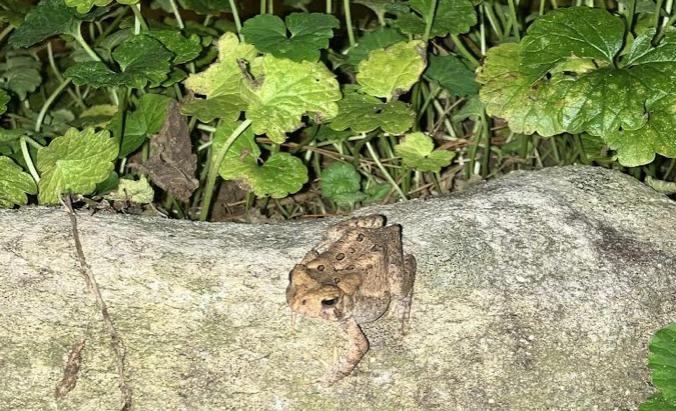A Farewell to Frogs
The rapid disappearance of amphibians could cause an ecological disaster on a worldwide scale.
Eastern American Toads, like this one, hop around damp areas in western PA.
December 20, 2022
The balance of life is dependent on a group of extraordinary creatures that are rapidly disappearing from the globe. Amphibian populations are plummeting at never before seen rates, and their extinction could cause mass anarchy in the natural world. Should we allow these amazing animals to disappear, the fate of life on Earth may be in jeopardy.
Animals are divided into five distinct “families” — mammals, reptiles, fish, birds, and amphibians. Amphibians are the group of creatures that include frogs, toads, newts, salamanders, and other slimy, cold-blooded vertebrae. Amphibians are commonly grouped in with the reptile family, which includes snakes, lizards, turtles, alligators, and other scaly beasts. However, amphibians live part of their complicated life cycle in water, setting them apart from all other families.
Whereas the majority of fish, reptiles, birds, and mammals live in a relatively stable state of existence, amphibians have undergone a sharp decline in recent years threatening biodiversity ecological stability on a worldwide scale.
Since the 1980’s, ecologists have observed a steady decline in the number of amphibian species. The main cause is still unknown, but we know that many smaller factors have played a role in steady amphibian extermination, some of which include climate change, habitat loss, pollution, invasive species, and a recently discovered fungal epidemic.
Amphibians, unlike many other animal families, are incredibly susceptible to any sort of environmental alteration. Because they are cold-blooded, regulating temperature is a key aspect of amphibian life. The unnatural climate change brought about by humans and the shifting geological time periods have caused proper homeostasis (a self-regulating process by which biological systems maintain stability while adjusting to changing external conditions) to become difficult for many amphibian species.
Moreover, amphibians are covered in thin layers of slime and evolutionary, life-sustaining chemicals. These fluids are of paramount importance for any amphibian. Because amphibians breathe through their skin, the layers of mucous allow them to retain necessary moisture, allowing oxygen to enter their bodies but also leaving them vulnerable to any sort of external altercation.
For example, any kind of pollution, chemical, or disease that meets an amphibian’s skin can cause it to become unwell. Only a small amount of unfamiliar chemicals is needed to cause harm to an amphibian. Even the oil secreted from human hands can ruin parts of an amphibian’s vital breathing mechanism. Even miniscule amounts of human interference with an amphibian’s environment to have drastic and potentially fatal impacts.
The gradual extinction of amphibians presents an ecological disaster the likes of which humans have never seen before. Amphibians play an integral role in any environment. In addition to balancing food webs as both predator and prey, amphibians are the primary predators of many insects, including the highly dangerous mosquitoes that spread a plethora of diseases.
In addition, the previously mentioned toxins that coat an amphibian’s skin have various medicinal uses for humans. For example, within the eggs of an axolotl salamander lies an extract that can suppress tumors in breast cancer. The ability for amphibians to regrow limbs has also been observed as a way to regenerate damaged cells during cancer. The neurotoxins found on many newts are also being experimented with medicinally to combat a variety of illnesses.
The extinction of amphibians could have major repercussions for nearly every aspect of the natural world. Diseases may spread uncontrollably, harmful insects may hatch in overabundance, and the biodiversity of earth may suffer greatly. A world without frogs, toads, newts, and salamanders would be a dark place for all life. The potential of an amphibian mass extinction shows us how intricate and fragile life on earth can be. With amphibian populations decreasing at almost 4% every year, the future for our slimy friends seems grim.
Some groups are beginning to spread awareness about this imminent threat to life on earth. Bowerbird Collective, an Australian music group that focuses on the revival of indigenous culture and natural conservation, recently released a new installment in their Songs of Disappearance collection. The most recent song, “Australian Frog Calls,” features the croaks and cries of over 60 species of endangered frogs found in Australia. The song gained traction and for a time surpassed both Taylor Swift and Paul Kelly in the Australian music charts.
As wintertime begins to take its icy grasp of the natural world, many amphibians will seek refuge in the warmth of the ground, only emerging in the light of spring. Perhaps, this year, when our amphibious allies awake from their season of hibernation, they will find themselves in a more understanding world where a welcoming future for these wonderful and vital creatures is possible.












